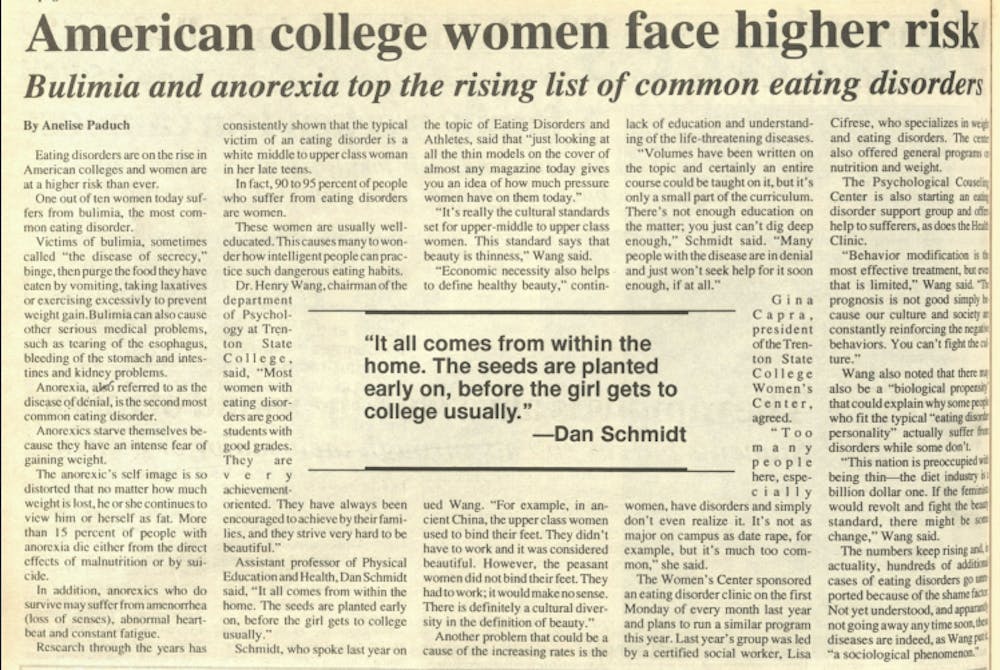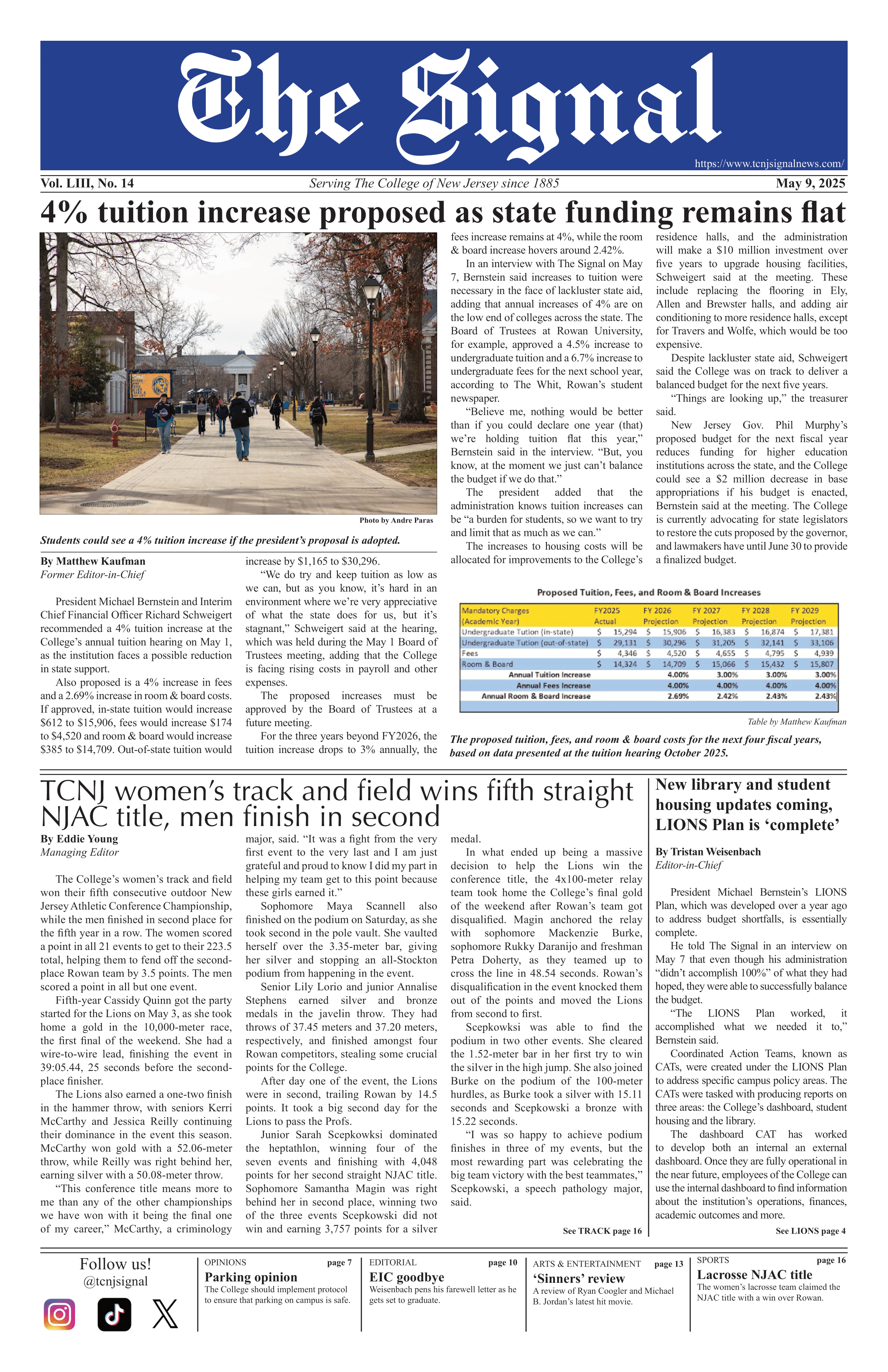With World Mental Health Day being last week, it’s important to shine a light on mental health issues that are not discussed frequently. According to The National Association of Anorexia Nervosa and Associated Disorders, every 62 minutes, at least one person dies as a direct result from an eating disorder.

In this October 1994 issue of The Signal, a writer shined a light on the fact that eating disorders were on the rise in American colleges, with women being at a higher risk than ever. Twenty-five years later, not only are eating disorders prominent in college students, they affect all races and ethnic groups
By Anelise Paduch
Eating disorders are on the rise in American colleges and women are at a higher risk than ever.
One out of ten women today suffers from bulimia, the most common eating disorder.
Victims of bulimia, sometimes called "the disease of secrecy," binge, then purge the food they have eaten by vomiting, taking laxatives or exercising excessively to prevent weight gain. Bulimia can also cause other serious medical problems, such as tearing of the esophagus, bleeding of the stomach and intestines and kidney problems.
Anorexia, also referred to as the disease of denial, is the second most common eating disorder.
Anorexics starve themselves because they have an intense fear of gaining weight.
The anorexic's self image is so distorted that no matter how much weight is lost, he or she continues to view him or herself as fat. More than 15 percent of people with anorexia die either from the direct effects of malnutrition or by suicide.
In addition, anorexics who do survive may suffer from amenorrhea (loss of senses), abnormal heartbeat and constant fatigue.
Research through the years has consistently shown that the typical victim of an eating disorder is a white middle to upper class woman in her late teens.
In fact, 90 to 95 percent of people who suffer from eating disorders are women.
These women are usually well educated. This causes many to wonder how intelligent people can practice such dangerous eating habits.
Dr. Henry Wang, chairman of the department of Psychology at Trenton State College, said, "Most women with eating disorders are good students with good grades. They are very achievement oriented. They have always been encouraged to achieve by their families, and they strive very hard to be beautiful."
Assistant professor of Physical Education and Health, Dan Schmidt said, "It all comes from within the home. The seeds are planted early on, before the girl gets to college usually."
Schmidt, who spoke last year on the topic of Eating Disorders and Athletes, said that "just looking at all the thin models on the cover of almost any magazine today gives you an idea of how much pressure women have on them today."
"It's really the cultural standards set for upper-middle to upper class women. This standard says that beauty is thinness," Wang said.
"Economic necessity also helps to define healthy beauty," continued Wang. "For example, in ancient China, the upper class women used to bind their feet. They didn't have to work and it was considered beautiful. However, the peasant women did not bind their feet. They had to work; it would make no sense. There is definitely a cultural diversity in the definition of beauty."
Another problem that could be a cause of the increasing rates is the lack of education and understanding of the life-threatening diseases.
"Volumes have been written on the topic and certainly an entire course could be taught on it, but it's only a small part of the curriculum. There's not enough education on the matter; you just can't dig deep enough," Schmidt said. "Many people with the disease are in denial and just won't seek help for it soon enough, if at all."
Gina Capra, president of the Trenton State College Women's Center, agreed.
"Too many people here, especially women, have disorders and simply don't even realize it. It's not as major on campus as date rape, for example, but it's much too common," she said.
The Women's Center sponsored an eating disorder clinic on the first Monday of every month last year and plans to run a similar program this year. Last year's group was led by a certified social worker, Lisa Cifrese, who specializes in and eating disorders. The center also offered general programs nutrition and weight.
The Psychological Counseling Center is also starting a disorder support group and help to sufferers, as does the Health Clinic.
"Behavior modification is the most effective treatment, but that is limited," Wang said. "The prognosis is not good simply because our culture and society are constantly reinforcing the negative behaviors. You can't fight the culture."
Wang also noted that there may also be a "biological propensity” that could explain why some people who fit the typical "eating disorder personality" actually suffer from disorders while some don't.
"This nation is preoccupied with being thin—the diet industry is a billion dollar one. If the feminists would revolt and fight the beauty standard, there might be some change," Wang said.
The numbers keep rising and, in actuality, hundreds of additional cases of eating disorders go unreported because of the shame factor. Not yet understood, and apparently not going away any time soon, these diseases are indeed, as Wang put it, "a sociological phenomenon.”







